Swedes
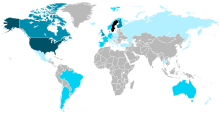 | |
| Total population | |
|---|---|
| c.13 million[a] | |
| Regions with significant populations | |
Other significant population centers: | |
| Swedish citizens abroad | c.546,000[c][2] |
| Swedish diaspora | c.4.5–5 million |
| 4,347,703(2013; ancestry)[3] 29,000(Swedish citizens)[3] | |
| 341,845(2011;ancestry[4] 26,000(sole ancestry)[4] | |
| c.290,000(2008)[d][5][2] | |
| 100,000[6] | |
| 36,887[7]–90,000[8] | |
| 30,375(2006; ancestry)[9] | |
| 30,000[10][11] | |
| 23,000[12] | |
| 23,000 (ancestry)[13] | |
| 20,385[14] | |
| 16,620[15] | |
| 15,000[16] | |
| 8,000[17][18] | |
| 7,400[19] | |
| 6,800[19] | |
| 4,600[19] | |
| 4,000[19] | |
| 3,233[20] | |
| 2,560[21] | |
| 2,500[19] | |
| 2,300[19] | |
| 2,000[19] | |
| 1,800[19] | |
| 1,775[22] | |
| 1,600[19] | |
| 1,911(2018; ancestry)[23]
Swedish minorities with a longer history | |
| 811(2021)[24] | |
| c.200(2022)[25] | |
| Languages | |
| Swedish | |
| Religion | |
| PrimarilyLutheranChristianity (Church of Sweden)[26] For further details, seeReligion in Sweden | |
^aThe total figure is merely an estimation; sum of all the referenced populations who claim Swedish ancestry worldwide and as such might be misleading or exaggerated. ^bSince there are no official statistics regarding ethnicity in Sweden, the number does not include ethnic Swedes who were born abroad but now repatriated to Sweden, nor does it includeSwedish-speaking Finnsin Sweden; est. for year 2015. ^cThis figure overlaps with those listed under diaspora as most Swedish citizens have emigrated to those countries listed lower in the infobox. ^d
TheSwedish-speaking FinnsorFinland-Swedesform aminority groupin Finland. The characteristic of this minority is debated: while some see it as an ethnic group of its own[27]some view it purely as a linguistic minority.[28]The group includes about 265,000 people, comprising 5.10% of the population of mainland Finland, or 5.50%[29]if the 26,000 inhabitants of Åland are included (there are also about 60,000 Swedish-speaking Finns currently resident in Sweden). It has been presented that the ethnic group can also be perceived as a distinct Swedish-speaking nationality in Finland.[30]There are also 9,000 Swedish citizens living in Finland.[31] | |
Swedes(Swedish:svenskar) are anethnic groupnative toSweden,who share a common ancestry,culture,historyandlanguage.They mostly inhabit Sweden and the otherNordic countries,in particularFinland where they are an officially recognized minority,[d]with Swedish being one of the official languages of the country, and with a substantialdiasporain other countries, especially theUnited States.
Etymology
[edit]The English term "Swede" has been attested in English since the late 16th century and is ofMiddle Dutchor MiddleLow Germanorigin.[32]InSwedish,the term issvensk,which is from the name ofsvear(or Swedes), the people who inhabitedSvealandin eastern centralSweden,[33][34]and were listed asSuionesinTacitus' historyGermaniafrom the first century AD. The term is believed to have been derived from theProto-Indo-Europeanreflexive pronominalroot,*s(w)e,as theLatinsuus.The word must have meant "one's own (tribesmen)". The same root and original meaning is found in the ethnonym of the Germanic tribeSuebi,preserved to this day in the nameSwabia.[35][36][37]
History
[edit]Origins
[edit]
Like otherScandinavians,Swedes descend from the presumablyIndo-EuropeanBattle Axe cultureand also thePitted Ware culture.[38]Prior to the first century AD there is no written evidence andhistoriography is based solely on various forms of archeology.TheProto-Germanic languageis thought to have originated in the arrival of the Battle Axe culture in Scandinavia[39]and the Germanic tribal societies of Scandinavia were thereafter surprisingly stable for thousands of years.[40]The merger of the Battle Axe and Pitted Ware cultures eventually gave rise to theNordic Bronze Agewhich was followed by thePre-Roman Iron Age.Like otherNorth Germanic peoples,Swedeslikely emerged as a distinct ethnic group during this time.[41]

Swedes enters written proto-history with theGermaniaofTacitusin 98 AD. InGermania 44, 45he mentions the Swedes (Suiones) as a powerful tribe (distinguished not merely for their arms and men, but for their powerful fleets) with ships that had aprowin both ends (longships). Which kings (kuningaz) ruled these Suiones is unknown, butNorse mythologypresents a long line of legendary and semi-legendary kings going back to the last centuries BC. As for literacy in Sweden itself, therunic scriptwas in use among the south Scandinavian elite by at least the second century AD, but all that has survived from the Roman Period is curt inscriptions on artefacts, mainly of male names, demonstrating that the people of south Scandinavia spokeProto-Norseat the time, a language ancestral to Swedish and otherNorth Germanic languages.[citation needed]
Migration Age and Vendel Period
[edit]The migration age in Sweden is marked by theextreme weather events of 535–536which is believed to have shaken Scandinavian society to its core. As much as 50% of the population of Scandinavia is thought to have died as a result and the emergingVendel Periodshows an increased militarization of society.[42][43]Several areas with rich burial gifts have been found, including well-preserved boat inhumation graves atVendelandValsgärde,and tumuli atGamla Uppsala.These were used for several generations. Some of the riches were probably acquired through the control of mining districts and the production of iron. The rulers had troops of mounted elite warriors with costly armour. Graves of mounted warriors have been found with stirrups and saddle ornaments of birds of prey in gilded bronze with encrusted garnets. TheSutton Hoo helmetvery similar to helmets in Gamla Uppsala, Vendel and Valsgärde shows that theAnglo-Saxonelite had extensive contacts with Swedish elite.[44]
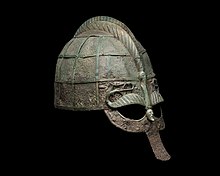
In the sixth centuryJordanesnamed two tribes, which he calls theSuehansand theSuetidi,who lived inScandza.The Suehans, he says, have very fine horses just as the Thyringi tribe (alia vero gens ibi moratur Suehans, quae velud Thyringi equis utuntur eximiis). The IcelanderSnorri Sturluson(1179–1241) wrote of the sixth-century Swedish kingAdils(Eadgils) that he had the finest horses of his days. The Suehans supplied black fox-skins for the Roman market. Then Jordanes names theSuetidiwhich is considered to be the Latin form ofSvitjod.He writes that the Suetidi are the tallest of men—together with theDani,who were of the same stock. Later he mentions other Scandinavian tribes as being of the same height.[citation needed]
Originating in semi-legendary Scandza (believed to be somewhere in modernGötaland,Sweden), aGothicpopulation had crossed theBaltic Seabefore the second century AD. They reachingScythiaon the coast of theBlack Seain modern Ukraine, where Goths left their archaeological traces in theChernyakhov culture.In the fifth and sixth centuries, they became divided as theVisigothsand theOstrogoths,and established powerful successor-states of theRoman Empirein theIberian peninsulaand Italy respectively.[45] Crimean Gothiccommunities appear to have survived intact in theCrimeauntil the late-18th century.[46]
Viking and Middle Ages
[edit]

The SwedishViking Agelasted roughly between the eighth and 11th centuries. During this period, it is believed that the Swedes expanded from eastern Sweden and incorporated theGeatsto the south.[47]It is believed that Swedish Vikings andGutarmainly travelled east and south, going to Finland, the Baltic countries, Russia,Belarus,Ukraine theBlack Seaand further as far asBaghdad.Their routes passedthrough the Dnieperdown south toConstantinople,on which they did numerous raids. TheByzantine EmperorTheophilosnoticed their great skills in war and invited them to serve as his personal bodyguard, known as thevarangian guard.The Swedish Vikings, called "Rus"are also believed to be the founding fathers ofKievan Rus.The Arabic travellerIbn Fadlandescribed these Vikings as following:
I have seen the Rus as they came on their merchant journeys and encamped by theItil.I have never seen more perfect physical specimens, tall as date palms, blond and ruddy; they wear neither tunics nor caftans, but the men wear a garment which covers one side of the body and leaves a hand free. Each man has an axe, a sword, and a knife, and keeps each by him at all times. The swords are broad and grooved, of Frankish sort.
— [48]
The adventures of these Swedish Vikings are commemorated on manyrunestonesin Sweden, such as theGreece Runestonesand theVarangian Runestones.There was also considerable participation in expeditions westwards, which are commemorated on stones such as theEngland Runestones.The last major Swedish Viking expedition appears to have been the ill-fated expedition ofIngvar the Far-TravelledtoSerkland,the region south-east of theCaspian Sea.Its members are commemorated on theIngvar Runestones,none of which mentions any survivor. What happened to the crew is unknown, but it is believed that they died of sickness.
Kingdom of Sweden
[edit]It is not known when and how the 'kingdom of Sweden' was born, but thelist of Swedish monarchsis drawn from the first kings who ruled bothSvealand(Sweden) andGötaland(Gothia) as one province withErik the Victorious.Sweden and Gothia were two separate nations long before that into antiquity. It is not known how long they existed, butBeowulfdescribed semi-legendarySwedish-Geatish warsin the sixth century.[citation needed]
Cultural advances
[edit]During the early stages of the Viking Age, a centre of trade in northern Europe developed atBirkaon the island ofBjörkö,not far from where Stockholm was later constructed, in mid-latitude Sweden. Birka was founded around 750 AD as a trading port by a king or merchants trying to control trade.[49]Birka was theBalticlink in theDnieper Trade RoutethroughLadoga(Aldeigja) andNovgorod(Holmsgard) to theByzantine Empireand theAbbasid Caliphate.[50]It was abandonedc. AD 975,around the same timeSigtunawas founded as a Christian town some 35 km to the northeast. It has been estimated that the population in Viking Age Birka was between 500 and 1000 people.[49]Archaeological finds indicate that Birka was still wealthy in the 9th and 10th centuries. Thousands of graves, coins, jewelry and other luxury items have been found there.[51] St. Ansgaris usually credited for introducing Christianity in 829, but the new religion did not begin to fully replacepaganismuntil the 12th century. During the 11th century, Christianity became the most prevalent religion, and from 1050 Sweden is counted as a Christian nation. The period between 1100 and 1400 was characterized by internal power struggles and competition among the Nordic kingdoms. Swedish kings also began to expand the Swedish-controlled territory in Finland, creating conflicts with the Rus who no longer had any connection with Sweden.[52]
Feudal institutions in Sweden
[edit]Except for the province ofSkåne,on the southernmost tip of Sweden which was under Danish control during this time,feudalismnever developed in Sweden as it did in the rest of Europe.[53]Therefore, the peasantry remained largely a class of free farmers throughout most of Swedish history.Slavery(also calledthralldom) was not common in Sweden,[54]and what slavery there was tended to be driven out of existence by the spread of Christianity, the difficulty in obtaining slaves from the lands east of the Baltic Sea, and by the development of cities before the 16th century[55]Indeed, both slavery andserfdomwere abolished altogether by a decree of KingMagnus IV Erikssonin 1335. Former slaves tended to be absorbed into the peasantry and some became laborers in the towns. Still, Sweden remained a poor and economically backward country in which barter was the means of exchange. For instance, the farmers of the province ofDalslandwould transport their butter to the mining districts of Sweden and exchange it there for iron, which they would then take down to the coast and trade the iron for fish they needed for food while the iron would be shipped abroad.[56]

- Minors and Regents
A large number of children inherited the Swedish crown over the course of the kingdom's existence. KingChristian II of Denmarkordered a massacre in 1520 of Swedish nobles at Stockholm. This came to be known as the "Stockholm blood bath"and stirred the Swedish nobility to new resistance and, on 6 June (now Sweden's national holiday) in 1523, they madeGustav Vasatheir king.[57]This is sometimes considered as thefoundation of modern Sweden.Shortly afterwards he rejectedCatholicismand led Sweden into theProtestant Reformation.Economically, Gustav Vasa broke the monopoly of the Hanseatic League over Swedish Baltic Sea trade.[58]
The Hanseatic League had been officially formed atLübeckonthe sea coastofNorthern Germanyin 1356. The Hanseatic League sought civil andcommercialprivileges from the princes and royalty of the countries and cities along the coasts of the Baltic Sea.[59]In exchange they offered a certain amount of protection. Having their own navy the Hansa were able to sweep the Baltic Sea free of pirates.[60]The privileges obtained by the Hansa included assurances that only Hansa citizens would be allowed to trade from the ports where they were located. They also sought agreement to be free of all customs and taxes. With these concessions, Lübeck merchants flocked to Stockholm, Sweden and soon came to dominate the economic life of that city and made the port city of Stockholm into the leading commercial and industrial city of Sweden.[61]Under the Hanseatic trade two-thirds of Stockholm's imports consisted of textiles and one third of salt. Exports from Sweden consisted of iron and copper.[62]
However, the Swedes began to resent the monopoly trading position of the Hansa (mostly German citizens) and to resent the income they felt they lost to the Hansa. Consequently, when Gustav Vasa orGustav Ibroke the monopoly power of the Hanseatic League he was regarded as a hero to the Swedish people. History now views Gustav I as the father of the modern Swedish nation. The foundations laid by Gustav would take time to develop. Furthermore, when Sweden did develop and freed itself from the Hanseatic League and entered its golden era, the fact that the peasantry had traditionally been free meant that more of the economic benefits flowed back to them rather than going to a feudal landowning class.[63]This was not the case in other countries of Europe like Poland where the peasantry was still bound by serfdom and a strong feudalistic land owning system.
Swedish Empire
[edit]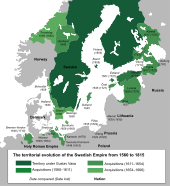
During the 17th century Sweden emerged as a Europeangreat power.Before the emergence of the Swedish Empire, Sweden was a very poor and scarcely populated country on the fringe of European civilization, with no significant power or reputation. Sweden rose to prominence on a continental scale during the tenure of kingGustavus Adolphus,seizing territories from Russia andPoland–Lithuaniain multiple conflicts, including theThirty Years' War.
During the Thirty Years' War, Sweden conquered approximately half of the Holy Roman states. Gustav Adolphus planned to become the newHoly Roman Emperor,ruling over a united Scandinavia and the Holy Roman states, but he died at theBattle of Lützenin 1632. After theBattle of Nördlingen,Sweden's only significant military defeat of the war, pro-Swedish sentiment among the German states faded. These German provinces excluded themselves from Swedish power one by one, leaving Sweden with only a few northern German territories:Swedish Pomerania,Bremen-VerdenandWismar.The Swedish armies may have destroyed up to 2,000 castles, 18,000 villages and 1,500 towns inGermany,one-third of all German towns.[64]
In the middle of the 17th century Sweden was the third largest country in Europe by land area, only surpassed by Russia and Spain. Sweden reached its largest territorial extent under the rule ofCharles Xafter thetreaty of Roskildein 1658.[65][66] The foundation of Sweden's success during this period is credited toGustav I's major changes on the Swedish economy in the 16th century, and his introduction ofProtestantism.[67]In the 17th century, Sweden was engaged in many wars, for example with thePolish–Lithuanian Commonwealthwith both sides competing for territories of today'sBaltic states,with the disastrousBattle of Kircholmbeing one of the highlights.[68]One-third of the Finnish population died in the devastatingfaminethat struck the country in 1696.[69]Famine also hit Sweden, killing roughly 10% of Sweden's population.[70]
The Swedes conducted a series of invasions into thePolish–Lithuanian Commonwealth,known as theDeluge.After more than half a century of almost constant warfare, the Swedish economy had deteriorated. It became the lifetime task of Charles' son,Charles XI,to rebuild the economy and refit the army. His legacy to his son, the coming ruler of SwedenCharles XII,was one of the finest arsenals in the world, a large standing army and a great fleet. Sweden's largest threat at this time, Russia, had a larger army but was far behind in both equipment and training.

After theBattle of Narvain 1700, one of the first battles of theGreat Northern War,the Russian army was so severely decimated that Sweden had an open chance to invade Russia. However, Charles did not pursue the Russian army, instead turning against Poland–Lithuania and defeating the Polish kingAugustus IIand his Saxon allies at theBattle of Kliszowin 1702. This gave Russia time to rebuild and modernize its army.[citation needed]
After the success of invading Poland, Charles decided to make an invasion attempt of Russia which ended in a decisive Russian victory at theBattle of Poltavain 1709. After a long march exposed tocossackraids, Russian TsarPeter the Great'sscorched-earthtechniques andthe extremely cold winter of 1709,the Swedes stood weakened with a shattered morale and enormously outnumbered against the Russian army at Poltava. The defeat meant the beginning of the end for the Swedish Empire.[citation needed]

Charles XII attempted to invade Norway 1716; however, he was shot dead atFredriksten fortressin 1718. The Swedes were not militarily defeated at Fredriksten, but the whole structure and organization of the Norwegian campaign fell apart with the king's death, and the army withdrew.[citation needed]
Forced to cede large areas of land in theTreaty of Nystadin 1721, Sweden also lost its place as an empire and as the dominant state on the Baltic Sea. With Sweden's lost influence, Russia emerged as an empire and became one of Europe's dominant nations. As the war finally ended in 1721, Sweden had lost an estimated 200,000 men, 150,000 of those from the area of present-day Sweden and 50,000 from theFinnishpart of Sweden.[71]
In the 18th century, Sweden did not have enough resources to maintain its territories outside Scandinavia, and most of them were lost, culminating with the 1809 loss of eastern Sweden to Russia which became the highly autonomousGrand Principality of FinlandinImperial Russia.[citation needed]
In interest of reestablishing Swedish dominance in the Baltic Sea, Sweden allied itself against its traditional ally and benefactor, France, in theNapoleonic Wars.Sweden's role in theBattle of Leipziggave it the authority to force Denmark-Norway, an ally of France, to cede Norway to the King of Sweden on 14 January 1814 in exchange for northern German provinces, at theTreaty of Kiel.The Norwegian attempts to keep their status as a sovereign state were rejected by the Swedish king,Charles XIII.He launched a military campaign against Norway on 27 July 1814, ending in theConvention of Moss,which forced Norway into apersonal unionwith Sweden under the Swedish crown, which lasted until 1905. The 1814 campaign was the last war in which Sweden participated as a combatant.[72]
Modern history
[edit]
There was a significant population increase during the 18th and 19th centuries, which the writerEsaias Tegnérin 1833 attributed to "peace,vaccine,andpotatoes".[73]Between 1750 and 1850, the population in Sweden doubled. Sweden was hit by the last natural caused famine in Europe, theFamine of 1867-69killed thousands in Sweden. According to some scholars, mass emigration to America became the only way to prevent famine and rebellion; over 1% of the population emigrated annually during the 1880s.[74] Nevertheless, Sweden remained poor, retaining a nearly entirely agricultural economy even as Denmark and Western European countries began to industrialize.[74][75]
Many looked towards America for a better life during this time. It is believed that between 1850 and 1910 more than one million Swedes moved to the United States.[76] In the early 20th century, more Swedes lived inChicagothan inGothenburg(Sweden's second largest city).[77]Most Swedish immigrants moved to theMidwestern United States,with a large population inMinnesota,with a few others moving to other parts of the United States and Canada.
Despite the slow rate of industrialization into the 19th century, many important changes were taking place in the agrarian economy because of innovations and the large population growth.[78]These innovations included government-sponsored programs ofenclosure,aggressive exploitation of agricultural lands, and the introduction of new crops such as the potato.[78]Because the Swedish peasantry had never been enserfed as elsewhere in Europe,[79]the Swedish farming culture began to take on a critical role in the Swedish political process, which has continued through modern times with modern Agrarian party (now called the Centre Party).[80]Between 1870 and 1914, Sweden began developing the industrialized economy that exists today.[81]
Strong grassroots movements sprung up in Sweden during the latter half of the 19th century (trade unions,temperancegroups, and independent religious groups), creating a strong foundation of democratic principles. In 1889 The Swedish Social Democratic Party was founded. These movements precipitated Sweden's migration into a modern parliamentary democracy, achieved by the time of World War I. As theIndustrial Revolutionprogressed during the 20th century, people gradually began moving into cities to work in factories and became involved insocialistunions. A communist revolution was avoided in 1917, following the re-introduction ofparliamentarism,and the country saw comprehensivedemocraticreforms under the joint Liberal-Social Democrat cabinet ofNils EdénandHjalmar Branting,with universal and equal suffrage to both houses of parliament enacted for men in 1918 and for women in 1919. The reforms were widely accepted by KingGustaf V,who had previously oustedKarl Staaff's elected Liberal government in theCourtyard Crisisbecause of differences in defence policy.
World Wars
[edit]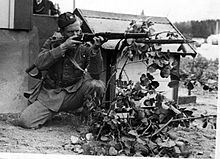
Sweden remained officially neutral during World War I and World War II, although its neutrality during World War II has been disputed.[82][83]Sweden was under German influence for much of the war, as ties to the rest of the world were cut off through blockades.[82]The Swedish government felt that it was in no position to openly contest Germany,[84]and therefore made some concessions.[85]Sweden also supplied steel and machined parts to Germany throughout the war. However, Sweden supported Norwegian resistance, and in 1943 helped rescue Danish Jews from deportation toNazi concentration camps.[86]Sweden also supported Finland in theWinter Warwith volunteers andmateriel.[87]
Toward the end of the war, Sweden began to play a role in humanitarian efforts and many refugees, among them many Jews from Nazi-occupied Europe, were saved partly because of the Swedish involvement in rescue missions at the internment camps and partly because Sweden served as a haven for refugees, primarily from theNordic countriesand theBaltic states.[84]Nevertheless, internal and external critics have argued that Sweden could have done more to resist the Nazi war effort, even if risking occupation although doing so would likely have resulted in even greater number of casualties and prevented many humanitarian efforts.[84]
Post-war era
[edit]Sweden was officially a neutral country and remained outsideNATOorWarsaw pactmembership during theCold War,but privately Sweden's leadership had strong ties with the United States and other western governments.[citation needed]
Following the war, Sweden took advantage of an intact industrial base, social stability and its natural resources to expand its industry to supply the rebuilding of Europe.[88]Sweden was part of theMarshall Planand participated in the Organization of Economic Co-operation and Development (OECD). During most of the post-war era, the country was governed by theSwedish Social Democratic Partylargely in cooperation withtrade unionsand industry. The government actively pursued an internationally competitive manufacturing sector of primarily large corporations.[89]
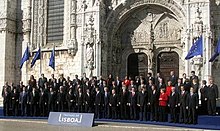
Sweden, like countries around the globe, entered a period of economic decline and upheaval, following the oil embargoes of 1973–74 and 1978–79.[90]In the 1980s pillars of Swedish industry were massively restructured. Shipbuilding was discontinued, wood pulp was integrated into modernized paper production, the steel industry was concentrated and specialized, and mechanical engineering was robotized.[91]
Between 1970 and 1990 the overall tax burden rose by over 10%, and the growth was low compared to other countries in Western Europe. The marginal income tax for workers reached over 80%[citation needed].Eventually government spent over half of the country'sgross domestic product.Sweden GDP per capita ranking declined during this time.[89]
Recent history
[edit]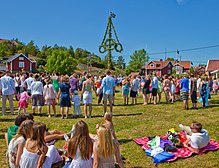
A burstingreal estatebubble caused by inadequate controls on lending combined with an international recession and a policy switch from anti-unemployment policies to anti-inflationary policies resulted in a fiscal crisis in the early 1990s.[92]Sweden's GDP declined by around 5%. In 1992, there was a run on the currency, with the central bank briefly increasing interest to 500%.[93][94]
The response of the government was to cut spending and institute a multitude of reforms to improve Sweden's competitiveness, among them reducing thewelfare stateandprivatisingpublic services and goods. Much of the political establishment promoted EU membership, and the Swedish referendum passed with 52% in favour of joining the EU on 13 November 1994. Sweden joined theEuropean Unionon 1 January 1995.
Sweden remains non-aligned militarily, although it participates in some joint military exercises withNATOand some other countries, in addition to extensive cooperation with other European countries in the area of defence technology and defence industry. Among others, Swedish companies export weapons that are used by the American military in Iraq.[95]Sweden also has a long history of participating in international military operations, including most recently,Afghanistan,where Swedish troops are under NATO command, and in EU sponsored peacekeeping operations inKosovo,Bosnia and Herzegovina,andCyprus.Sweden held the chair of theEuropean Unionfrom 1 July to 31 December 2009.
Timeline of Swedish history
[edit]
Language
[edit]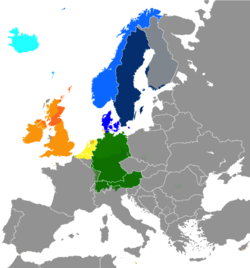
North Germanic languagesWest Germanic languages
The native language of nearly all Swedes isSwedish(svenska[ˈsvɛ̂nːska]) aNorth Germaniclanguage, spoken by approximately 10 million people,[96]predominantly in Sweden and parts of Finland, especially along its coast and on theÅlandislands. It is, to a considerable extent,mutually intelligiblewithNorwegianand to a lesser extent with spokenDanish(see especially "Classification"). Along with the other North Germanic languages, Swedish is a descendant ofOld Norse,the common language of theGermanic peoplesliving in Scandinavia during theViking Era.It is the largest of the North Germanic languages by numbers of speakers.
Standard Swedish,used by most Swedish people, is the national language that evolved from the Central Swedish dialects in the 19th century and was well established by the beginning of the 20th century. While distinct regionalvarietiesdescended from the older ruraldialectsstill exist, the spoken andwritten languageis uniform and standardized. Some dialects differ considerably from the standard language ingrammarandvocabularyand are not always mutually intelligible with Standard Swedish. These dialects are confined to rural areas and are spoken primarily by small numbers of people with lowsocial mobility.Though not facing imminentextinction,such dialects have been in decline during the past century, despite the fact that they are well researched and their use is often encouraged by local authorities.[citation needed]
Genetics
[edit]According to recent genetic analysis, both mtDNA and Y chromosome polymorphisms showed a noticeablegenetic affinitybetween Swedes and otherGermanicethnic groups.[97]
Paternally,through theirY-DNA haplogroups,the Swedes are quite diverse and show strongly ofHaplogroup I1d1at over 40% of the population tested in different studies, followed byR1a1aandR1b1a2a1a1with over 20% each andhaplogroup N1c1with over 5% at different regional variance. The rest are within haplogroupsJandE1b1b1and other less common ones.[98][citation needed]
Maternally,through theirmtDNA haplogroups,the Swedes show very strongly ofhaplogroup Hat 25–30%, followed byhaplogroup Uat a 10% or more, withhaplogroup JandT,Kat around 5% each.[citation needed]
Geographic distribution
[edit]
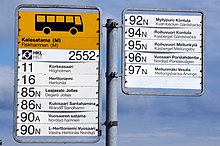
The largest area inhabited by Swedes, as well as the earliest known original area inhabited by their linguistic ancestors, is in the country of Sweden, situated on the eastern side of theScandinavian Peninsulaand the islands adjacent to it, situated west of theBaltic Seainnorthern Europe.The Swedish-speaking people living in near-coastal areas on the north-eastern and eastern side of the Baltic Sea also have a long history of continuous settlement, which in some of these areas possibly started about amillenniumago[citation needed].These people include the Swedish-speakers inmainland Finland– speaking a Swedish dialect commonly referred to asFinland Swedish(finlandssvenska which is part of the East-Swedish dialect group) and the almost exclusively Swedish-speaking population ofÅlandspeaking in a manner closer to the adjacent dialects in Sweden than to adjacent dialects of Finland Swedish.Estoniaalso had an importantSwedish minoritywhich persisted for about 650 years onthe coast and isles.Smaller groups of historical descendants of 18th–20th-century Swedish emigrants who still retain varying aspects of Swedish identity to this day can be found in theAmericas(especiallyMinnesotaandWisconsin;seeSwedish Americans) and in Ukraine.
Currently, Swedes tend to emigrate mostly to the Nordic neighbour countries (Norway, Denmark, Finland), English speaking countries (United States, United Kingdom, Australia, Canada, New Zealand), Spain, France and Germany.[99]
Historically, the Kingdom of Sweden has been much larger than nowadays, especially during "The Era of Great Power" (Swedish Empire) in 1611–1718. Finland belonged to Sweden until 1809.[100]Since there was no separate Finnish nationality at those times, it is not unusual that sources predating 1809 refer both to Swedes and Finns as "Swedes". This is particularly the case withNew Sweden,where some of the Swedish settlers were of Finnish origin.
Questionnaire surveys of Swedish embassies conducted by Swedes Worldwide, a non-profit organization, have shown a steady growth of Swedes living outside Sweden. The 2022 survey indicates an approximate 685,000 Swedes living abroad, up from 660,000 in 2015 and 546,000 in 2011.[101]
| Country | 2011 | 2015 | 2022 |
|---|---|---|---|
| United States | 100,000 | 150,000 | 179,000 |
| Spain | 90,000 | 90,000 | 104,000 |
| United Kingdom | 90,000 | 90,000 | 100,000 |
| Norway | 80,000 | 90,000 | 39,600 |
| France | 30,000 | 30,000 | 30,000 |
| Germany | 18,000 | 23,000 | 22,500 |
| Finland | 13,000 | 15,000 | 17,500 |
| Denmark | 13,000 | 15,000 | 17,000 |
| Switzerland | 17,000 | 10,000 | 16,000 |
| Italy | 10,000 | 12,000 | 15,500 |
| Australia | 8,000 | 11,000 | 10,000 |
| Belgium | 10,000 | 10,000 | 10,000 |
| Iraq | — | 500 | 10,000 |
| Netherlands | 5,500 | 6,500 | 8,000 |
| Canada | 7,000 | 7,000 | 5,800 |
| Portugal | — | 3,500 | 5,500 |
| Poland | — | 1,500 | 5,500 |
| Chile | 1,000 | 5,000 | 5,000 |
| United Arab Emirates | — | 4,000 | 5,000 |
| Thailand | 10,000 | 20,000 | 4,500 |
| Israel | — | 4,000 | 4,000 |
| Malta | — | 2,000 | 4,000 |
| Austria | — | 3,500 | 3,700 |
| New Zealand | 3,000 | 3,000 | 3,300 |
| Brazil | 2,000 | 4,000 | 3,000 |
| Serbia | — | 4,000 | 3,000 |
| Ireland | 3,500 | 3,500 | 3,000 |
| Iran | — | 1,000 | 3,000 |
| Turkey | — | 1,000 | 3.000 |
| Bosnia and Herzegovina | — | 500 | 3,000 |
See also
[edit]- Demographics of Sweden
- List of Swedes
- List of Swedish actors
- List of Swedish film directors
- List of Swedish musicians
- List of Swedish scientists
- List of Swedish sportspeople
- Swedish diaspora
- List of Germanic peoples
- Swedish Americans
- Swedish Australian
References
[edit]- ^"Befolkningsstatistik i sammandrag 1960–2015".27 March 2016. Archived fromthe originalon 27 March 2016.Retrieved20 August2017.
- ^abEwa Hedlund (2011) "Utvandrare.nu – Från emigrant till global svenskArchived20 October 2017 at theWayback Machine".Föreningen svenskar i världen. p. 42ISBN978-91-979795-0-4
- ^abBureau, U.S. Census."American FactFinder – Results".Factfinder2.census.gov.Archived fromthe originalon 15 February 2015.Retrieved20 August2017.
- ^abStatistics Canada(8 May 2013)."2011 National Household Survey: Data tables".Archivedfrom the original on 24 December 2018.Retrieved8 March2014.
- ^Rapo, Markus."Tilastokeskus – Väestörakenne 2008".tilastokeskus.fi.Archivedfrom the original on 9 April 2020.Retrieved2 March2010.
- ^"About us".Londonsvenskar.LondonSwedes.Archivedfrom the original on 13 April 2021.Retrieved23 December2016.
Approximately 100 000 Swedes live in London and the UK, with about 500 000 Swedish tourists visiting the UK capital annually.
- ^Personer med innvandringsbakgrunn, etter innvandringskategori, landbakgrunn og kjønnArchived20 October 2017 at theWayback MachineSSB, retrieved 13 July 2015
- ^"Fakta om Norge".Utlandsjobb.nu.Archived fromthe originalon 24 December 2016.Retrieved23 December2016.
90 000 svenskar bor i Norge
- ^2006 Australian CensusArchived22 July 2008 at theWayback MachineReports 30,375 people of Swedish Ancestry
- ^"Relations bilatérales entre la Suède et la France".Archivedfrom the original on 18 December 2023.Retrieved4 January2023.
- ^"Présentation de la Suède".France Diplomatie:: Ministère de l'Europe et des Affaires étrangères.Archivedfrom the original on 15 April 2021.Retrieved6 August2017.
- ^"Fakta om Tyskland".Utlandsjobb.nu.Archived fromthe originalon 24 December 2016.Retrieved23 December2016.
23 000 svenskar bor i Tyskland.
- ^"Imigrantes Suecos ao Brasil genealogy project".Geni family tree.Archivedfrom the original on 18 April 2021.Retrieved18 April2021.
- ^"TablaPx".Ine.es.Archivedfrom the original on 25 May 2017.Retrieved1 November2020.
- ^"Map Analyser".Statistikbanken(in Danish).Archivedfrom the original on 22 September 2020.Retrieved15 May2020.
- ^"Swedes in Thailand".Bangkok Post.Archivedfrom the original on 17 April 2023.Retrieved13 April2021.
- ^"SEFSTAT"(PDF).Archived(PDF)from the original on 20 March 2022.Retrieved13 February2022.
- ^"Portugal's Swedish NHR pensioners get the bad news".Archivedfrom the original on 28 May 2023.Retrieved28 May2023.
- ^abcdefghi"Swedish people".Joshua Project.Archivedfrom the original on 21 September 2020.Retrieved10 August2020.
- ^"statistiche e distribuzione per regione".Tuttitalia.it(in Italian).Archivedfrom the original on 8 February 2020.Retrieved15 May2020.
- ^"Czy Szwedzi uciekają do Polski? Liczba przybywających osób od lat utrzymuje się na stałym poziomie"[Are the Swedes fleeing to Poland? The number of people arriving has remained steady for years]. Archived fromthe originalon 9 August 2019.
- ^"Ở lưu người nước ngoài thống kê ( cũ đăng lục người nước ngoài thống kê )"[Statistics on foreign residents (formerly registered statistics on foreigners)] (in Japanese). 15 December 2023.Retrieved28 April2024.
- ^"2018 Census ethnic group summaries | Stats NZ".stats.govt.nz.Archivedfrom the original on 27 September 2021.Retrieved27 September2021.
- ^2000 population and housing census(in Estonian and English). Vol. 2. Statistikaamet (Statistical Office of Estonia). 2021.ISBN978-9985-74-202-0.Archivedfrom the original on 17 April 2023.Retrieved10 June2022.
- ^Malitska, Julia (2017).Negotiating Imperial Rule Colonists and Marriage in the Nineteenth-century Black Sea Steppe(PDF)(PhD). Huddinge, Sweden: Södertörn University.ISBN978-91-87843-93-8.Archived(PDF)from the original on 13 March 2022.Retrieved3 March2021.
- ^"Statistik".Svenskakyrkan.se.Archivedfrom the original on 1 November 2017.Retrieved20 August2017.
- ^"...Finland has a Swedish-speaking minority that meets the four major criteria of ethnicity, i.e. self-identification of ethnicity, language, social structure and ancestry (Allardt and Starck, 1981; Bhopal, 1997).
- ^[1]Archived31 March 2009 at theWayback Machine...As language is actually the basic or even the only criterion that distinguishes these two groups from each other, it is more correct to speak of Finnish-speakers and Swedish-speakers in Finland instead of Finns and Finland Swedes. Nowadays the most common English term denoting the latter group is 'the Swedish-speaking Finns'.
- ^"Population and Society".stat.fi.Archived fromthe originalon 11 October 2004.
- ^The identity of the Swedish[-speaking] minority [in Finland] is however clearly Finnish (Allardt 1997:110). But their identity is twofold: They are both Finland Swedes and Finns (Ivars 1987). (Die Identität der schwedischen Minderheit ist jedoch eindeutig finnisch (Allardt 1997:110). Ihre Identität ist aber doppelt: sie sind sowohl Finnlandschweden als auch Finnen (Ivars 1987).)Saari, Mirja: Schwedisch als die zweite Nationalsprache Finnlands.Retrieved 10 December 2006.
- ^"It is not correct to call a nationality a linguistic group or minority, if it has developed culture of its own. If there is not only a community of language, but also of other characteristics such as folklore, poetry and literature, folk music, theater, behavior, etc." "The concept of nation has a different significance as meaning of a population group or an ethnic community, irrespectively of its organization. For instance, the Swedes of Finland, with their distinctive language and culture form a nationality which under the Finnish constitution shall enjoy equal rights with the Finnish nationality". "In Finland this question (Swedish nationality) has been subjected to much discussion. The Finnish majority tries to deny the existence of a Swedish nationality. An example of this is the fact that the statutes always use the concept"'Swedish-speaking' instead of 'Swedish'".Tore Modeen,The cultural rights of the Swedish ethnic group in Finland(Europa Ethnica, 3–4 1999, jg.56)
- ^"the definition of Swede".Dictionary.Archivedfrom the original on 4 March 2007.Retrieved20 September2015.
- ^"OSA – Om svar anhålles".g3.spraakdata.gu.se.Archivedfrom the original on 12 July 2023.Retrieved20 September2015.
- ^"OSA – Om svar anhålles".g3.spraakdata.gu.se.Archivedfrom the original on 12 July 2023.Retrieved20 September2015.
- ^Noreen, A.Nordens äldsta folk- och ortnamn(i Fornvännen 1920 sid 32).
- ^"Indogermanisches Etymologisches Woerterbuch [Pokorny]: Query result".13 June 2011. Archived fromthe originalon 13 June 2011.
- ^"915 (Svensk etymologisk ordbok)".Runeberg.org.16 August 2017.Archivedfrom the original on 10 August 2007.Retrieved20 August2017.
- ^*Malmström, Helena (19 January 2015)."Ancient mitochondrial DNA from the northern fringe of the Neolithic farming expansion in Europe sheds light on the dispersion process".Proceedings of the Royal Society B.370(1660).Royal Society:20130373.doi:10.1098/rstb.2013.0373.PMC4275881.PMID25487325.
- ^Aubin, Hermann. "History of Europe: Barbarian migrations and invasions The Germans and Huns". Encyclopædia Britannica Online. Retrieved 13 July 2018.
- ^Waldman, Carl; Mason, Catherine (2006). pp. 830–831. Encyclopedia of European Peoples. Infobase Publishing. ISBN 978-1438129181.
- ^Sørensen, Marie Louise Stig. "History of Europe: The Bronze Age". Encyclopædia Britannica Online. Retrieved 13 July 2018.
- ^Ström, Folke: Nordisk Hedendom, Studentlitteratur, Lund 2005, ISBN 91-44-00551-2 (first published 1961) among others, refer to the climate change theory.
- ^Eriksson, Benny (9 May 2016)."Mytisk extremvinter visade sig stämma".SVT.Archivedfrom the original on 12 July 2023.Retrieved9 August2021.
- ^Bruce-Mitford, Rupert (1974). Aspects of Anglo-Saxon Archaeology: Sutton Hoo and Other Discoveries. London: Victor Gollancz.
- ^Goth (people)Archived2 May 2015 at theWayback Machine.Britannica Online Encyclopedia.
- ^Ingemar Nordgren (2004). "The Well Spring of the Goths: About the Gothic Peoples in the Nordic Countries and on the ContinentArchived17 April 2023 at theWayback Machine".iUniverse. p. 520ISBN0-595-33648-5
- ^"Sweden".The Columbia Encyclopedia(Sixth ed.). bartleby. 2000. Archived fromthe originalon 11 April 2009.
- ^Quoted from: Gwyn Jones.A History of the Vikings.Oxford University Press, 2001.ISBN0-19-280134-1.Page 164.
- ^abPrice, T. Douglas; Arcini, Caroline; Gustin, Ingrid; Drenzel, Leena; Kalmring, Sven (March 2018)."Isotopes and human burials at Viking Age Birka and the Mälaren region, east central Sweden".Journal of Anthropological Archaeology.49:19–38.doi:10.1016/j.jaa.2017.10.002.
- ^2006Encyclopædia Britannica.Article "Birca".
- ^Andersson (1975), p. 34
- ^Bagge, Sverre (2005) "The Scandinavian Kingdoms". InThe New Cambridge Medieval History.Eds.Rosamond McKittericket al. Cambridge University Press, 2005.ISBN0-521-36289-X,p. 724: "Swedish expansion in Finland led to conflicts with Rus', which were temporarily brought to an end by a peace treaty in 1323, dividing the Karelian peninsula and the northern areas between the two countries."
- ^Franklin D. Scott,Sweden: The Nation's History(University of Minnesota Press: Minneapolis, 1977) p. 58.
- ^TräldomArchived9 October 2017 at theWayback Machine.Nordisk familjebok / Uggleupplagan. 30. Tromsdalstind – Urakami /159–160, 1920. (In Swedish)
- ^Scott, p. 55.
- ^Scott, pp. 55–56.
- ^Scott, p. 121.
- ^Scott, p. 132.
- ^Robert S. Hoyt & Stanley Chodorow,Europe in the Middle Ages(Harcourt, Brace & Jovanovich, Inc.: New York, 1976) p. 628.
- ^John B. Wolfe,The Emergence of European Civilization(Harper & Row Pub.: New York, 1962) pp. 50–51.
- ^Scott, p. 52.
- ^Scott
- ^Scott, pp. 156–157.
- ^"Population".History Learningsite.Archivedfrom the original on 20 May 2015.Retrieved24 May2008.
- ^ "A Political and Social History of Modern Europe V.1./Hayes..." Hayes, Carlton J. H. (1882–1964), Title: A Political and Social History of Modern Europe V.1., 2002-12-08, Project Gutenberg, webpage: Infomot-7hsr110Archived17 November 2007 at theWayback Machine.
- ^However, Sweden's largest territorial extent lasted from 1319 to 1343 withMagnus Erikssonruling all of thetraditional lands of Swedenand Norway.
- ^ "Gustav I Vasa – Britannica Concise" (biography), Britannica Concise,2007, webpage: EBConcise-Gustav-I-VasaArchived21 June 2006 at theWayback Machine.
- ^"Battle of Kircholm 1605".Kismeta. Archived fromthe originalon 14 June 2009.Retrieved25 August2010.
- ^Finland and the Swedish EmpireArchived9 October 2017 at theWayback Machine.Source:U.S. Library of Congress
- ^Elizabeth Ewan, Janay Nugent (2008) "Finding the family in medieval and early modern ScotlandArchived17 April 2023 at theWayback Machine".Ashgate Publishing.p. 153ISBN0-7546-6049-4
- ^"Indelta soldater – Indelningsverket (UTF-8)".Algonet.se.30 May 2012. Archived fromthe originalon 30 May 2012.Retrieved20 August2017.
- ^"Sweden celebrates 200 years of peace".The Local Sweden.15 August 2014.Archivedfrom the original on 12 July 2023.Retrieved29 June2022.
- ^Magocsi, Paul R.;Multicultural History Society of Ontario (1999),Encyclopedia of Canada's Peoples,University of Minnesota Press,ISBN978-0-8020-2938-6
- ^ab Einhorn, Eric and John Logue (1989). Modern Welfare States: Politics and Policies in Social Democratic Scandinavia.Praeger Publishers, p. 9: "Though Denmark, where industrialization had begun in the 1850s, was reasonably prosperous by the end of the nineteenth century, both Sweden and Norway were terribly poor. Only the safety valve of mass emigration to America prevented famine and rebellion. At the peak of emigration in the 1880s, over 1% of the total population of both countries emigrated annually."
- ^Koblik, Steven (1975). Sweden's Development from Poverty to Affluence 1750–1970, University of Minnesota Press, pp. 8–9, "In economic and social terms the eighteenth century was more a transitional than a revolutionary period. Sweden was, in light of contemporary Western European standards, a relatively poor but stable country. [...] It has been estimated that 75–80% of the population was involved in agricultural pursuits during the late eighteenth century. One hundred years later, the corresponding figure was still 72%."
- ^Einhorn, Eric and John Logue (1989), p. 8.
- ^Beijbom, Ulf (1996)."European emigration: A Review of Swedish Emigration to America".Americanwest (Courtesy The House of Emigrants, Växjö, Sweden). Archived fromthe originalon 5 December 2010.
- ^abKoblik, pp. 9–10.
- ^Sweden: Social and economic conditionsArchived30 May 2008 at theWayback Machine(2007). InEncyclopædia Britannica.Encyclopædia Britannica Online. Retrieved 19 February 2007.
- ^Koblik, p. 11: "The agrarian revolution in Sweden is of fundamental importance for Sweden's modern development. Throughout Swedish history the countryside has taken an unusually important role in comparison with other European states."
- ^Koblik, p. 90. "It is usually suggested that between 1870 and 1914 Sweden emerged from its primarily agrarian economic system into a modern industrial economy."
- ^abKoblik, pp. 303–313.
- ^Nordstrom, p. 315: "Sweden's government attempted to maintain at least a semblance of neutrality while it bent to the demands of the prevailing side in the struggle. Although effective in preserving the country's sovereignty, this approach generated criticism at home from many who believed the threat to Sweden was less serious than the government claimed, problems with the warring powers, ill feelings among its neighbours, and frequent criticism in the postwar period."
- ^abcNordstrom, pp. 313–319.
- ^Zubicky, Sioma (1997).Med förintelsen i bagaget(in Swedish). Stockholm: Bonnier Carlsen. p. 122.ISBN91-638-3436-7.
- ^Hall, Laura (3 October 2023)."The town that stood up to the Nazis".BBC.Retrieved22 May2024.
- ^Pashakhanlou, Arash Heydarian; Berenskötter, Felix (2021). "Friends in war: Sweden between solidarity and self-help, 1939–1945".Cooperation and Conflict.56(1): 83–100.doi:10.1177/0010836720904389.ISSN0010-8367.
- ^Nordstrom, pp. 335–339.
- ^abGlobalization and Taxation: Challenges to the Swedish Welfare State.By Sven Steinmo.
- ^Nordstrom, p. 344: "During the last twenty-five years of the century a host of problems plagued the economies of Norden and the West. Although many were present before, the 1973 and 1980 global oil crises acted as catalysts in bringing them to the fore."
- ^Krantz, Olle and Lennart Schön. 2007. Swedish Historical National Accounts, 1800–2000. Lund: Almqvist and Wiksell International.
- ^Englund, P. 1990. "Financial deregulation in Sweden." European Economic Review 34 (2–3): 385–393. Korpi TBD. Meidner, R. 1997. "The Swedish model in an era of mass unemployment." Economic and Industrial Democracy 18 (1): 87–97. Olsen, Gregg M. 1999. "Half empty or half full? The Swedish welfare state in transition." Canadian Review of Sociology & Anthropology, 36 (2): 241–268.
- ^"Sweden's 'Crazy' 500% Interest Rate; Fails to Faze Most Citizens, Businesses; Hike Seen as Short-Term Move to Protect Krona From Devaluation".Highbeam. 18 September 1992. Archived fromthe originalon 15 February 2011.Retrieved3 August2010.
- ^Lars Jonung; Jaakko Kiander; Pentti Vartia (2009).The Great Financial Crisis in Finland and Sweden.Edward Elgar Publishing.ISBN978-1-84844-305-1.Archivedfrom the original on 17 April 2023.Retrieved29 October2015.
- ^The Local."New Swedish weapon in Iraq".Archived fromthe originalon 16 December 2006.Retrieved23 June2007.
- ^"Ethnologue report for Swedish".Archivedfrom the original on 23 September 2009.Retrieved9 February2009.gives the number of 8,789,835, but is based on data from 1986. Sweden has currently a population of 9.2 Mio (2008 census), and there are about 290,000 native speakers of Swedish in Finland"Statistics Finland – Population Structure".Archivedfrom the original on 11 June 2020.Retrieved9 February2009.(based on data from 2007), leading to an estimate of about 9 to 10 Mio.
- ^"Different genetic components in the Norwegian population revealed by the analysis of mtDNA and Y chromosome polymorphisms"(PDF).Archived fromthe original(PDF)on 27 September 2011.Retrieved27 September2011.
- ^"Haplogroups of the World"(PDF).Scs.uiuc.edu.Archived fromthe original(PDF)on 28 July 2004.Retrieved20 August2017.
- ^"Flest svenskar tros bo i USA, Norge och Finland. Därefter följer Danmark, Storbritannien, Spanien och Tyskland".Archived fromthe originalon 30 June 2010.
- ^"The history of the Finland- Swedes".Svenskfinland.6 September 2019.Archivedfrom the original on 7 July 2022.Retrieved19 July2022.
- ^ab"Svenskar i världen – Kartläggning 2022"(PDF).Archived fromthe original(PDF)on 9 July 2022.
External links
[edit]- VisitSweden—Sweden's official website for tourism and travel information
